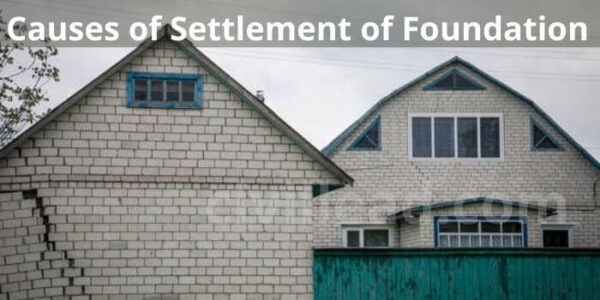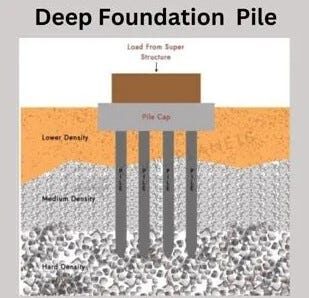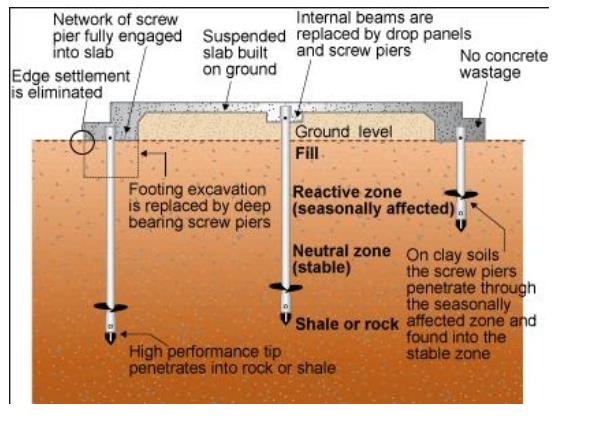A pier foundation, also known as a post foundation or column foundation, is a type of deep foundation commonly used in construction projects.
It consists of a series of vertical structural elements, typically made of reinforced concrete or steel, that are driven deep into the ground to transfer the load of a structure to a stronger, more stable soil layer or bedrock.
Pier foundations are particularly useful in situations where the upper soil layers are weak, compressible, or prone to settlement.
By extending the foundation to a firmer stratum, pier foundations provide superior load-bearing capacity and minimize the risk of structural damage caused by soil movement or settlement.
Pier foundations offer several advantages, including high load-bearing capacity, resistance to lateral forces, and adaptability to various soil conditions.
They are widely used in the construction of bridges, high-rise buildings, transmission towers, and other structures that require a stable and reliable foundation system.
However, the design and installation of pier foundations require specialized expertise and equipment, making them more complex and expensive compared to shallow foundation alternatives.

Pier foundation detail
Here are the detailed aspects of pier foundations:
Materials:
a. Reinforced concrete: Most common material, offering high compressive strength and durability.
b. Steel: Used for driven piles or as reinforcement cages in drilled piers.
c. Timber: Less common, but can be used for short piers in certain applications.
Design considerations:
a. Soil conditions: Type, strength, and stratification of soil layers.
b. Load requirements: Dead loads, live loads, and environmental loads.
c. Pier dimensions: Diameter, length, and spacing of piers.
d. Reinforcement: Amount and configuration of steel reinforcement.
e. Groundwater: Presence and level of groundwater table.
f. Seismic activity: Consideration of potential earthquake loads.
Construction process:
a. Site preparation: Clearing, grading, and leveling the site.
b. Excavation: Drilling or excavating holes for piers.
c. Reinforcement placement: Installing steel cages or pre-fabricated piles.
d. Concrete placement: Pouring concrete into the holes or hollow piles.
e. Curing: Allowing concrete to harden and gain strength.
f. Quality control: Testing concrete samples and ensuring proper installation.
Load transfer mechanism:
a. End-bearing piers: Transfer loads to the bottom of the pier, relying on the bearing capacity of the deep soil layer or bedrock.
b. Friction piers: Transfer loads through friction between the pier surface and the surrounding soil.

Pier foundation types
The main types of pier foundations include:
Drilled Piers (Bored Piles):
- Holes are drilled into the ground using augers or drill rigs.
- Reinforcement cages are placed in the drilled holes.
- Concrete is poured into the holes to form the piers.
- Suitable for various soil conditions and high load-bearing requirements.
Driven Piles:
a. Precast Concrete Piles:
- Precast concrete piles are manufactured off-site and transported to the construction site.
- Piles are driven into the ground using a pile driver or hammer.
- Suitable for soft to medium soil conditions and moderate load-bearing requirements.
b. Steel Piles:
- Steel H-piles, pipe piles, or sheet piles are driven into the ground.
- Suitable for soft to dense soil conditions and high load-bearing requirements.
- Ideal for applications with limited access or headroom.
Caissons:
a. Drilled Caissons:
- Similar to drilled piers, but larger in diameter (usually >1m).
- Reinforcement cages are placed, and concrete is poured in-situ.
- Suitable for very high load-bearing requirements and deep soil layers.
b. Box Caissons:
- Large, hollow, pre-fabricated boxes are sunk into the ground.
- Suitable for underwater construction or where a watertight foundation is required.
c. Pneumatic Caissons:
- Pressurized caissons that allow workers to excavate and level the bottom of the caisson.
- Used in deep water or difficult soil conditions.
Micro Piles:
- Small-diameter piles (usually <300mm) drilled into the ground.
- Reinforcement bars or steel pipes are inserted, and cement grout is injected.
- Suitable for underpinning existing foundations or where access is limited.
Screw Piles (Helical Piles):
- Steel shafts with helical bearing plates are screwed into the ground.
- Suitable for light to moderate load-bearing requirements and where rapid installation is needed.
Timber Piles:
- Wooden poles are driven into the ground using a pile driver.
- Suitable for light to moderate load-bearing requirements and in areas with abundant timber resources.
- Less common in modern construction due to durability concerns.
Merits and demerits
Advantages:
a. High load-bearing capacity
b. Resistance to lateral forces and overturning moments
c. Adaptability to various soil conditions
d. Reduced settlement and differential settlement
e. Suitable for areas with high water tables or poor surface soils
Disadvantages:
a. Higher cost compared to shallow foundations
b. Requires specialized equipment and skilled labor
c. Longer construction time
d. Potential noise and vibration during installation
e. Difficulty in modifying or replacing piers after construction
Conclusion
They are designed to transfer the loads of a structure to a stronger, more stable soil layer or bedrock, providing excellent load-bearing capacity and resistance to lateral forces.
Pier foundations come in various types, Each type has its own advantages and is suitable for different soil conditions, load requirements, and construction methods.
The choice of pier foundation type depends on a thorough analysis of site-specific conditions and design requirements by geotechnical and structural engineers.
Compared to shallow foundations, pier foundations offer superior performance in challenging soil conditions, such as weak or compressible soils, high water tables, or areas prone to settlement.
However, pier foundations also have some drawbacks, such as higher costs, longer construction times, and the need for specialized equipment and skilled labor. Additionally, modifying or replacing pier foundations after construction can be difficult and expensive.







